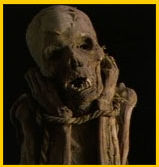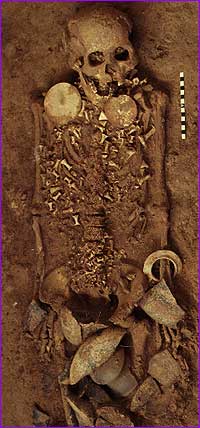The Incas were probably
one of the most religious cultures in history. Nearly every single aspect
of their lives involved the worship of some sort of idol. They worshipped
through prayers, dances, and sacrifices. Sacrifices were the most important
form of worship. The Incas sacrificed a wide variety of things, ranging
from objects they created, to crops they grew, to livestock, to their own
children. The type of sacrifice they made depended on the importance of
the god the gift was for and the seriousness of the situation they were
involved in. Human sacrifice was only done for very special occasions and
in crisis situations. The guidelines for sacrifice were very specific had
to be followed exactly. To change the order of a ceremony would mean that
the gods would not be pleased and would bring more problems. At a ceremony
there would be much drinking and dancing that were part of the ritual.
Sacrifices would be accompanied by prayers as well. Like the sacrifices,
prayers had to be recited in a specific manor, and only by priests. There
were many prayers for many situations.
All these sacrifices and
prayers were offered to the most important things in the Inca culture,
their deities. Incas were incredibly idolatrous, they idolized a wide variety
of things, from dirt to the Sun. The Incas did have a hierarchy of gods,
the top being Viracocha, or sometimes called
Pachayachachic, or "Creator
of the World." Viracocha was the supreme being that created all the other
gods. Viracocha also created the light and the dark, the earth and the
sea, land and water, and all the things that are of the earth. This is
a prayer to Viracocha for the health and general well being of the people!
O Creator without equal,
you are at the ends of the world, you gave life and valor to mankind,
saying "Let there be man"
and for the women, "Let there be woman"; You made them, formed
them and gave them life
so that they will live safe and sound in peace without danger! Where are
you? by chance do you live high up in the sky or down below on earth or
in the clouds and
storms? hear me, respond
to me and consent to my plea, giving us perpetual life and taking us
with your hand, and receive
this offering wherever you are, O Creator!
Here is another example.
O Sun, my father, who said
"Let there be Cuzco!" and by your will it was founded and it is
preserved with such grandeur!
Let these sons of yours, the Incas, be conquerors and despoilers of
all mankind. We adore you
and offer this sacrifice to you so that you will grant us what we beg of
you. Let them be prosperous and make them happy, and do not allow them
to be conquered by anyone, but let them always be conquerors, since you
made them for that purpose.
 The
bodies of the wealthy, both men and women,
The
bodies of the wealthy, both men and women,  were wrapped in fine tapestry. The men would have beside them in the grave
his implements used in war, hunting and fishing. Also, sometimes the finest
pottery vessels or other objects of gold or silver would go along-side
the body as well. Along with these possessions would be a supply of food,
coca leaves, and some other items used in day to day life. These were left
for the journey the body would travel to the next world.
were wrapped in fine tapestry. The men would have beside them in the grave
his implements used in war, hunting and fishing. Also, sometimes the finest
pottery vessels or other objects of gold or silver would go along-side
the body as well. Along with these possessions would be a supply of food,
coca leaves, and some other items used in day to day life. These were left
for the journey the body would travel to the next world.
The poor man was thrust
into a hole in the sand of the coast, or into a crevasse between the rocks
in the mountains. Beside him would be and ear of corn, a gourd or pottery
vessel for water, a few odd shaped stones, his amulets or charms
 The Incas of the coast region called their deceased bodies mummies. Some
of the bodies were
The Incas of the coast region called their deceased bodies mummies. Some
of the bodies were
found in vaults which were
covered with sticks and bushes. The bodies were placed in a sitting
position, knees drawn up
and the head resting upon them. The women are found with their work baskets.
In some places a fake head was attached to the mummy body; its significance
is unknown.
The Mummies of Inca Rulers
were treated as if they were still alive. Servants would still tend
to the estate of the deceased, and on important days of ceremony the mummies
would be brought out to celebrate with everyone else. On important
issues, some even consulted the mummies before taking action.
Very little is known about
Capacocha, the sacred Inca ceremony of human sacrifice, but with each new
archaeological discovery of a sacrificial mummy, more is revealed. The
earliest and only known written accounts of the ritual are chronicles written
by Spanish conquistador historians. From the chronicles and from each new
discovery of a mummy, the pieces of this great puzzle are put together
to reveal an intricate and extremely important ritual that involved sacrifice
of children, worship of mountains as gods, and elaborate burial procedures.
Home
Works Consulted: Bernabe
Cobo, Inca Religion and Customs (Austin: University of Texas
Press, 1990)
Geoffrey Conrad, Religion and Empire: The Dynamics of Aztec and
Inca Expansionism (New York: Cambridge University Press, 1984)
Picture Credits: All Mummies:
http://www.pbs.org/wgbh/nova/peru/mummies/
 The
bodies of the wealthy, both men and women,
The
bodies of the wealthy, both men and women,  were wrapped in fine tapestry. The men would have beside them in the grave
his implements used in war, hunting and fishing. Also, sometimes the finest
pottery vessels or other objects of gold or silver would go along-side
the body as well. Along with these possessions would be a supply of food,
coca leaves, and some other items used in day to day life. These were left
for the journey the body would travel to the next world.
were wrapped in fine tapestry. The men would have beside them in the grave
his implements used in war, hunting and fishing. Also, sometimes the finest
pottery vessels or other objects of gold or silver would go along-side
the body as well. Along with these possessions would be a supply of food,
coca leaves, and some other items used in day to day life. These were left
for the journey the body would travel to the next world.
 The Incas of the coast region called their deceased bodies mummies. Some
of the bodies were
The Incas of the coast region called their deceased bodies mummies. Some
of the bodies were